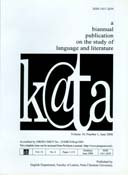Settings Transposition of the Scientific Elements in Hiroshi Teshigahara’s Adaptation of Kobo Abe’s the Face of Another
Abstract
This article focuses on Hiroshi Teshigahara’s film adaptation of the famous Kobo Abe’s The Face of Another with special attention on the transposition of the scientific elements of the novel in the film. This article observes how Teshigahara, through cinematic techniques, transposes Abe’s scientific language into visual forms. Abe himself involved in the film adaptation by writing the screenplay, in which he prioritized the literary aspects over the filmic aspect. This makes the adaptation become more interesting because Teshigahara is known as a stylish filmmaker. Another noteworthy aspect is the internal dialogues domination within the novel narration. It is written in an epistolary-like narration, placing the protagonist as a single narrator which consequently raises subjectivity. The way Teshigahara externalizes the stream-of-consciousness narration-like into the medium of film is another significant topic of this essay.
Keywords: transposition, scientific element, adaptation, The Face of Another
Downloads
References
Bolton, C. (2009). Sublime Voices: The Fictional Science and Scientific Fiction of Abe Kobo. Cambridge: Harvard UP.
Botting, F. & Wilson, S. (2002). Sexcrash. In Jane Arthurs & Iain Grant (Eds.), Crash Cultures (79-88). Bristol: Intellect Books.
Desser, D. (1988). Eros Plus Massacre: An Introduction to the Japanese New Wave Cinema. Bloomington: Indiana UP.
De Vaulx, J.B. (2012, September 30). The Collaborative Films of Teshigahara-Abe-Takemitsu and 1960s Japanese Cinema. Young and Innocent, 9a. Retrieved from http://www.youngandinnocent.eu/articles/2012/english/collaborative-films-teshigahara-abe-takemitsu-and-1960s-japanese-cinema/
Grilli, P. (2007, July 9). The Spectral Landscape of Teshigahara, Abe, and Takemitsu. Retrieved from https://www.criterion.com/current/posts/607-the-spectral-landscape-of-teshigahara-abe-and-takemitsu
Hutcheon, L. (2006). A Theory of Adaptation. New York: Routledge.
McDonald, K. I. (2000). From Book to Screen: Modern Japanese Literature in Film. Armonk: An East Gate Book.
McFarlane, B. (1996). Novel to Film: An Introduction to Theory of Adaptation. Oxford: Clarendon Press.
Matthew, R. (1989). Japanese Science Fiction: A View of a Changing Society. Worcester: Billing and Sons, Ltd.
Mellen, J. (1975). Voices from the Japanese Cinema. New York: Liveright.
Sakaki, A. (2005). Scratch the Surface, Film the Face: Obsession with the Depth and Seduction of the Surface in Abe Kobo’s The Face of Another, Japan Forum, 17(3), 369-88.
Teshigahara, H. (Producer), & Teshigahara, H. (Director). (15 July 1966). The Face of Another [Motion Picture]. Japan: Teshigahara Pro Tokyo Eiga Co.
Whittlesey, H. (2014, May 20). A Typology of Derivates: Translation, Transposition, Adaptation. Translation Journal. Retrieved from http://translationjournal.net/journal/60adaptation.htm

This work is licensed under a Creative Commons Attribution 4.0 International License.
![]() This work is licensed under a Creative Commons Attribution License
This work is licensed under a Creative Commons Attribution License




.png)
.png)

.png)












